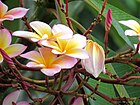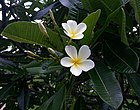Note: This is a project under development. The articles on this wiki are just being initiated and broadly incomplete. You can Help creating new pages.
Plumeria rubra
Plumeria rubra is a deciduous, semi-succulent shrub with a broad crown that is often as wide as the tree is tall. It can grow up to 12 metres tall in the wild but is usually smaller in cultivation. The boles of wild trees can be 25cm in diameter. The plant is often used as a herbal remedy. One of the most common and best known ornamental trees cultivated in the tropics. It is often planted near Asian temples, where the fragrant flowers are picked daily as religious offerings.
Uses
Gonorrhoea, Venereal sores, Scabies, Wounds, Amoebic dysentery, Muscular swellings, Boils, Rheumatic pain, Toothache, Centipede bites.[1]
Parts Used
Chemical Composition
It contains constituents, representing of flower essential oil and volatile extract were identified. Benzyl esters, aliphatic alkanes, oxygenated monoterpenes etc.[2]
Common names
| Language | Common name |
|---|---|
| Kannada | |
| Hindi | Golenchi |
| Malayalam | |
| Tamil | Nela sampangi |
| Telugu | Deva ganneru |
| Marathi | Chaempae |
| Gujarathi | |
| Punjabi | |
| Kashmiri | |
| Sanskrit | |
| English | Frangipani, Plumeria |
Properties
Reference: Dravya - Substance, Rasa - Taste, Guna - Qualities, Veerya - Potency, Vipaka - Post-digesion effect, Karma - Pharmacological activity, Prabhava - Therepeutics.
Dravya
Rasa
Guna
Veerya
Vipaka
Karma
Prabhava
Habit
Identification
Leaf
| Kind | Shape | Feature |
|---|---|---|
Flower
| Type | Size | Color and composition | Stamen | More information |
|---|---|---|---|---|
| {{{5}}} |
Fruit
| Type | Size | Mass | Appearance | Seeds | More information |
|---|---|---|---|---|---|
Other features
List of Ayurvedic medicine in which the herb is used
Where to get the saplings
Mode of Propagation
How to plant/cultivate
Frangipani is a plant of hot, dry to moderate rainfall areas, at elevations up to 600 metres.[5]
Commonly seen growing in areas
Photo Gallery
References
- ↑ Indian Medicinal Plants by C.P.Khare
- ↑ Chemical constituents
- ↑ Common names
- ↑ [Morphology]
- ↑ Cultivation
External Links
- Ayurvedic Herbs known to be helpful to treat Gonorrhoea
- Ayurvedic Herbs known to be helpful to treat Venereal sores
- Ayurvedic Herbs known to be helpful to treat Scabies
- Ayurvedic Herbs known to be helpful to treat Wounds
- Ayurvedic Herbs known to be helpful to treat Amoebic dysentery
- Ayurvedic Herbs known to be helpful to treat Muscular swellings
- Ayurvedic Herbs known to be helpful to treat Boils
- Ayurvedic Herbs known to be helpful to treat Rheumatic pain
- Ayurvedic Herbs known to be helpful to treat Toothache
- Ayurvedic Herbs known to be helpful to treat Centipede bites
- Herbs with Flowers used in medicine
- Herbs with common name in Hindi
- Herbs with common name in Tamil
- Herbs with common name in Telugu
- Herbs with common name in Marathi
- Herbs with common name in English
- Habit - Deciduous tree
- Index of Plants which can be propagated by Seeds
- Index of Plants which can be propagated by Stem tip cuttings
- Index of Plants which can be propagated by Layering
- Herbs that are commonly seen in the region of Rocky lowland
- Herbs that are commonly seen in the region of Hot areas
- Herbs that are commonly seen in the region of Often rocky forest
- Herbs that are commonly seen in the region of Mountain slopes
- Herbs that are commonly seen in the region of Occasionally on plains
- Herbs
- Pages without herbs images





